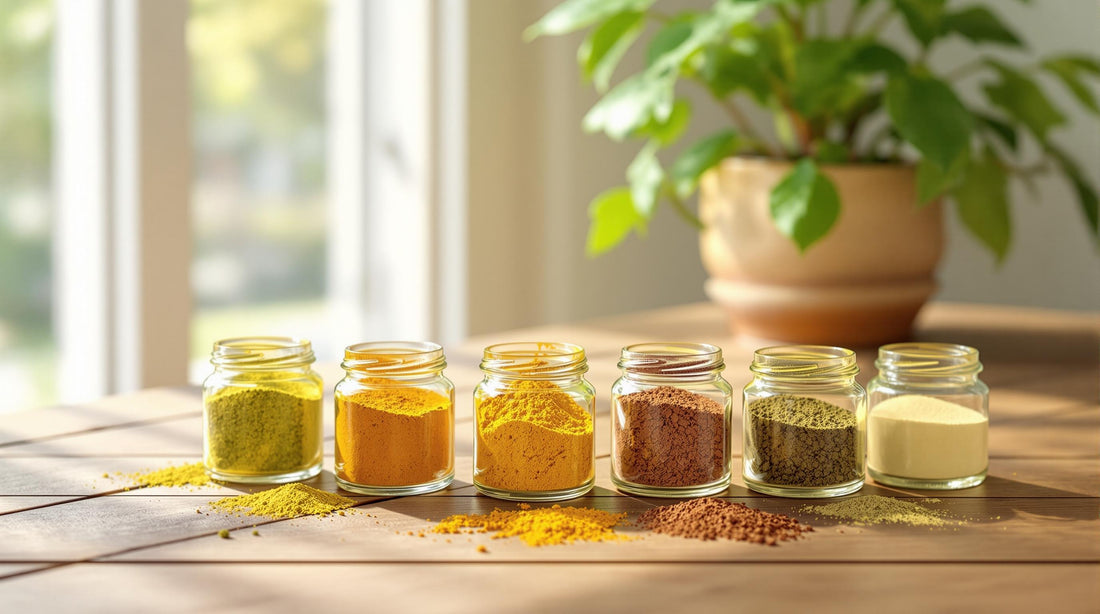
7 Natural Remedies for Hair Loss: Ayurvedic Solutions
Hair loss can be frustrating, but Ayurveda offers natural ways to restore hair health by addressing root causes like imbalanced doshas and stress. Here are 7 Ayurvedic remedies to help you reduce hair fall and promote growth:
- Bhringraj: Known as the "king of hair", this herb strengthens follicles and encourages growth. Use as an oil or paste.
- Amla: Rich in vitamin C, it nourishes hair, prevents graying, and boosts collagen. Apply as oil, masks, or consume daily.
- Shirodhara: Warm herbal oil therapy improves scalp circulation and reduces stress.
- Shiro Abhyanga: Scalp massages with herbal oils nourish roots and prevent hair thinning.
- Dietary Tips: Tailor your meals to your dosha, focus on fresh, nutrient-rich foods, and stay hydrated.
- Lifestyle Changes: Maintain a consistent sleep schedule, practice yoga, and reduce stress for better hair health.
- Nasya Therapy: Detoxify through nasal oil treatments to support scalp and follicle health.
Key Timeline:
- 1-3 months: Reduced hair fall.
- 4-6 months: Noticeable new growth.
Ayurveda emphasizes consistency and a holistic approach for long-term results. Combine these remedies with a balanced lifestyle for healthier, stronger hair.
Ancient Ayurvedic Hair Growth Secret: Weekly Natural Hair Treatment
1. Bhringraj: A Herb for Hair Growth

Bhringraj (Eclipta alba), often called "the king of hair" in Ayurvedic medicine, is a natural remedy for hair loss. It addresses the root causes of hair fall and encourages healthy growth through its unique properties [2][4].
Research highlights that Bhringraj helps hair follicles shift into the growth phase, resulting in thicker hair. Studies even compare its effectiveness to Minoxidil, but without the common side effects like irritation or itching [2]. This makes it especially useful for strengthening follicles and reducing premature hair loss [2].
You can use Bhringraj as an oil, paste, or powder. Apply it to your scalp 2-3 times a week for 4-6 months to notice improvements [4]. Beyond promoting growth, it helps prevent early graying and supports maintaining your hair's natural color [2][4].
2. Amla: A Natural Source of Hair Nutrition
Amla, also known as Indian gooseberry, is a well-known Ayurvedic remedy for hair loss. Packed with vitamin C and antioxidants, it helps strengthen hair and encourages growth.
Amla works by addressing imbalances that contribute to hair loss, creating a supportive environment for healthier hair while protecting it from damage.
Dr. Ajmera describes Amla as "an excellent hair tonic that strengthens roots, maintains color, and enhances luster" [3].
How to Use Amla in Your Hair Care Routine
| Method | Instructions | Benefits |
|---|---|---|
| Oil Treatment | Massage warm Amla oil into your scalp 2-3 times a week | Strengthens roots and boosts circulation |
| Hair Mask | Mix Amla powder with coconut oil, apply overnight | Provides deep nourishment to follicles |
| Internal Use | Take 1-2 tablespoons of Amla juice daily | Supports hair health from the inside out |
With consistent use, you may notice stronger hair and less hair fall within 4-6 months. The vitamin C in Amla helps boost collagen, which strengthens hair, while its antioxidants protect hair follicles from damage.
When trying Amla for the first time, start with small amounts to check for any irritation. Some people may experience sensitivity, so it’s wise to consult an Ayurvedic practitioner - especially if you’re on medications or have scalp conditions.
Adding Amla to your routine can work well alongside other Ayurvedic practices. For example, treatments like Shirodhara can further support the health of your scalp and hair.
3. Shirodhara: A Therapy for Better Scalp Circulation

Shirodhara, a term from Sanskrit combining "Shiro" (head) and "dhara" (flow), is a traditional Ayurvedic treatment that targets both physical and mental contributors to hair loss. The process involves gently pouring warm herbal oils in a steady stream over the forehead and scalp.
How Shirodhara Supports Hair Health
This therapy offers two main benefits for hair: it boosts scalp circulation and helps reduce stress, a frequent trigger for hair loss.
| Oil Type | Benefits |
|---|---|
| Sesame Oil | Penetrates deeply, warms the scalp |
| Coconut Oil | Calms and cools sensitive scalps |
| Bhringraj Oil | Enhances circulation, strengthens hair |
Treatment Process
Shirodhara sessions are typically done once or twice a week, with each session lasting about 45 minutes. This allows the oils to deeply penetrate and improve circulation.
"The use of Shirodhara in combination with other Ayurvedic practices has been shown to promote significant hair growth and reduce hair fall" [1].
Things to Keep in Mind
If you have high blood pressure or sinus issues, speak with a practitioner before starting Shirodhara. For added benefits, pair it with Shiro Abhyanga, a scalp massage treatment that directly nourishes the scalp.
sbb-itb-5c7cdb5
4. Shiro Abhyanga: Scalp Massage for Hair Health

Shiro Abhyanga is an Ayurvedic scalp massage that focuses on nourishing the scalp and strengthening hair roots. Unlike Shirodhara, which emphasizes stress relief, this practice directly targets hair health through specific massage techniques. It's a natural way to address hair loss and encourage healthier hair growth.
Using warm, herbal oils during the massage boosts blood flow to the scalp and feeds the hair follicles. This practice not only strengthens the hair shaft but also helps prevent premature graying. Oils like sesame, coconut, and bhringraj - commonly associated with Shirodhara - are just as beneficial for Shiro Abhyanga.
For best results, aim to perform Shiro Abhyanga once or twice a week. During dry seasons, consider increasing to twice weekly for added hydration. To ensure you're using the right oils for your dosha and applying the correct technique, consult an Ayurvedic practitioner.
"Oiling the body (known as abhyanga) is a major concept in Ayurveda... It has water and earth elements in it that are both cooling and strengthening for hair." - Ajmera, as quoted in Harper's Bazaar [3]
Shiro Abhyanga plays a key role in Ayurvedic hair care. When combined with treatments like Shirodhara and dietary changes, it tackles hair loss from the root cause. This integrated approach sets the stage for the lifestyle and dietary tips we'll cover next.
5. Dietary Tips to Support Hair Growth
In Ayurveda, tailoring your diet to your dosha type is a key step in supporting hair growth and minimizing hair loss. Proper digestion plays a big role here - it helps your body absorb nutrients more effectively, which directly benefits your hair follicles. Stick to warm, freshly cooked meals and avoid processed or refrigerated foods whenever possible.
| Dosha Type | Recommended Foods |
|---|---|
| Vata | Warm soups, stews, nuts, seeds |
| Pitta | Cucumbers, melons, cooling herbs |
| Kapha | Light fruits, leafy greens, ginger |
Certain nutrients are especially important for hair health, including vitamins A, C, and E, along with iron and zinc. Bhringraj tea is also a popular Ayurvedic option for promoting hair growth [2][4]. These dietary changes reflect Ayurveda's approach of balancing the body and mind to improve overall hair health.
Stay hydrated with coconut water or fresh juices to keep your scalp and hair moisturized [1]. If stress is contributing to hair loss, focus on calming foods and cut back on caffeine and alcohol, as these can disrupt nutrient absorption [1].
For even better results, try to eat at consistent times each day. This simple habit helps regulate your body's natural rhythms, making it easier for your system to absorb nutrients. Combined with Ayurvedic practices like Shiro Abhyanga (discussed earlier), these dietary tips can make a noticeable difference.
While diet works from the inside out, pairing it with lifestyle changes can further improve your hair's overall health and reduce hair loss.
6. Lifestyle Adjustments for Stronger Hair
Making small changes in your daily habits can help improve hair health, especially when following Ayurvedic principles. One key factor is sleep - try to stick to a routine of sleeping between 10 PM and 6 AM to align with your body’s natural rhythms. To wind down effectively, dim the lights and avoid screens before bedtime.
| Time of Day | Suggested Activities |
|---|---|
| Morning (6-8 AM) | Oil massage, meditation |
| Afternoon (2-4 PM) | Yoga, breathing exercises |
| Evening (9-10 PM) | Scalp massage, relaxation techniques |
Incorporating calming activities like yoga, pranayama (breathing exercises), and meditation can help balance your doshas and support hair health. Here’s a simple plan you can follow:
- Spend 10-15 minutes daily on pranayama or gentle yoga.
- Dedicate 20 minutes to meditation or mindfulness exercises.
Taking regular breaks from screens also helps reduce stress, which plays a role in maintaining balanced doshas and overall well-being [1].
Customize these activities based on your dosha type for better results. For example:
- Vata types benefit from grounding activities like gentle yoga or massages.
- Pitta types should focus on cooling practices such as meditation or calming breathing techniques.
- Kapha types thrive with energizing movements like brisk yoga or active meditation [1][3].
For added protection, sleep on a silk pillowcase to minimize hair friction, and when spending time outdoors, cover your head to protect it from excessive sun exposure. This is especially important for managing Pitta dosha, as too much sun can lead to hair loss [3].
With consistent effort, most people see stronger hair and less hair fall within 8-12 weeks [1]. Combining these lifestyle adjustments with Ayurvedic treatments and a balanced diet can provide a comprehensive approach to improving your hair health.
7. Nasya: Detoxification for Hair and Scalp Health
Nasya therapy is an Ayurvedic treatment that involves applying herbal oils through the nose to detoxify and rejuvenate the scalp and body. This method works well alongside other Ayurvedic practices, such as maintaining a balanced diet and regular scalp massages.
Two oils are commonly used in Nasya therapy:
- Anu Tailam: Boosts circulation and helps reduce inflammation, making it ideal for addressing Vata and Pitta imbalances.
- Desi Ghee: Provides nourishment to tissues and supports follicle health, particularly useful for Kapha imbalances.
| Oil Type | Best For |
|---|---|
| Anu Tailam | Vata and Pitta issues |
| Desi Ghee | Kapha issues |
For optimal results, perform Nasya therapy 1-2 times a week in the morning. This treatment benefits hair health by improving scalp circulation through the nasal pathways, flushing out toxins that affect the scalp and hair follicles, reducing inflammation, and ensuring better nutrient delivery to the follicles.
Key Precautions:
- Avoid if you're sick or have nasal issues.
- Do not perform during menstruation.
- Wait until after digestion if you've recently eaten.
If you're new to Nasya, start with a milder option like Desi Ghee before trying stronger oils. After application, sit upright for 5-10 minutes to allow proper absorption. With regular use, many notice better scalp health within 4-6 weeks and reduced hair fall by the 8-week mark.
Conclusion
Ayurvedic remedies take a natural approach to addressing hair loss, using traditional herbs, therapies, and lifestyle changes to tackle underlying issues like dosha imbalances and toxins. Studies suggest that herbs such as bhringraj can be as effective as treatments like Minoxidil, but without the associated side effects [2][3].
Unlike chemical treatments, these natural methods align with the body’s processes, promoting lasting results without harmful impacts. However, Ayurvedic practices demand patience and consistency, as noticeable improvements often take time. By combining herbal remedies, therapeutic techniques, and lifestyle changes, you can create a well-rounded approach to healthier hair.
Here’s a practical timeline to guide your journey:
| Timeframe | Focus | Results |
|---|---|---|
| 1-3 Months | Oils, herbs, and therapies | Reduced hair fall |
| 4-6 Months | Consistent routine | Visible new growth |
The strength of Ayurveda lies in its ability to balance doshas while cleansing the body [1][3]. Tailoring treatments to your specific dosha can make them even more effective [3]. To maximize results, consider working with an Ayurvedic practitioner who can design a plan tailored to your unique needs and hair concerns.
